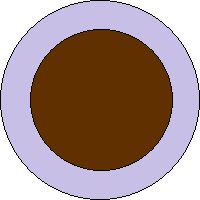Planetary system
Discovery
Erik A. Petigura and team analyzed data obtained from the Kepler space telescope during its observation of the K2 Campaign 2 field. They reported the discovery and confirmation of both planets b and c. [4] The Planetary signals were independently detected by Andrew Vanderburg and collaborators. [9]
Characteristics

The two known planets in this system have radii equal to 5.4 and 7.5 times that of the Earth. This places both planets radii between that of Uranus and Saturn, a range not present within the Solar System. With orbital periods of 20.9 days and 42.4 days, the planets are within 1% of the 2:1 mean-motion resonance. The low observed eccentricities and near orbital resonance provide evidence regarding the formation and evolution of the system, suggesting that they could possibly have resulted from gravitational interactions with a protoplanetary disk. K2-24c at 15.4 earth masses is significantly lighter than K2-24b's 19 Earth masses despite being a larger planet. It is estimated that K2-24b's atmosphere makes up 26% of its mass while K2-24c's atmosphere makes up 52%. The current model of core-nucleated accretion predicts that runaway accretion should occur when a planet reaches approximately 50% atmosphere by mass, this makes K2-24c a potential challenge to the model. [10]
There is also a candidate planet, K2-24d, with a mass of 53 ME and an orbital period of 470 days. While the radial velocity signal of planet was confirmed, no validation tests were run to confirm its existence, rendering it as unconfirmed. [6]
A transit observation of K2-24b with the Hubble Space Telescope's Wide Field Camera 3 suggested the presence of ammonia, in a high abundance, but did not find evidence for water. [11]
| Companion (in order from star) | Mass | Semimajor axis (AU) | Orbital period (days) | Eccentricity | Inclination | Radius |
|---|---|---|---|---|---|---|
| b | 19.0+2.2 −2.1 M🜨 | 0.1673+0.0034 −0.0056 | 20.88977+0.00034 −0.00035 [10] | 0.06±0.01 [10] | 89.63±0.25 ° | 5.638+0.065 −0.061 R🜨 |
| c | 16.4+1.3 −0.2 M🜨 | 0.262+0.014 −0.011 | 42.3391±0.0012 [10] | <0.05 [12] | 89.44+0.15 −0.11 ° | 7.93+0.12 −0.13 R🜨 |
| d(unconfirmed) | 54+9 −4 M🜨 | — | 469+10 −15 | 0.00 | — | — |